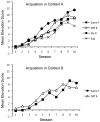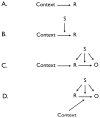Contextual control of discriminated operant behavior
- PMID: 24000907
- PMCID: PMC4028427
- DOI: 10.1037/xan0000002
Contextual control of discriminated operant behavior
Abstract
Previous research has suggested that changing the context after instrumental (operant) conditioning can weaken the strength of the operant response. That result contrasts with the results of studies of Pavlovian conditioning, in which a context switch often does not affect the response elicited by a conditioned stimulus. To begin to make the methods more similar, Experiments 1-3 tested the effects of a context switch in rats on a discriminated operant response (R; lever pressing or chain pulling) that had been reinforced only in the presence of a 30-s discriminative stimulus (S; tone or light). As in Pavlovian conditioning, responses and reinforcers became confined to presentations of the S during training. However, in Experiment 1, after training in Context A, a switch to Context B caused a decrement in responding during S. In Experiment 2, a switch to Context B likewise decreased responding in S when Context B was equally familiar, equally associated with reinforcement, or equally associated with the training of a discriminated operant (a different R reinforced in a different S). However, there was no decrement if Context B had been associated with the same response that was trained in Context A (Experiments 2 and 3). The effectiveness of S transferred across contexts, whereas the strength of the response did not. Experiment 4 found that a continuously reinforced response was also disrupted by context change when the same response manipulandum was used in both training and testing. Overall, the results suggest that the context can have a robust general role in the control of operant behavior. Mechanisms of contextual control are discussed.
Figures









Similar articles
-
A fundamental role for context in instrumental learning and extinction.Behav Processes. 2014 May;104:13-9. doi: 10.1016/j.beproc.2014.02.012. Epub 2014 Feb 24. Behav Processes. 2014. PMID: 24576702 Free PMC article. Review.
-
Effects of D-cycloserine on the extinction of appetitive operant learning.Behav Neurosci. 2011 Aug;125(4):551-9. doi: 10.1037/a0024403. Behav Neurosci. 2011. PMID: 21688894 Free PMC article.
-
Stimulus control of actions and habits: A role for reinforcer predictability and attention in the development of habitual behavior.J Exp Psychol Anim Learn Cogn. 2018 Oct;44(4):370-384. doi: 10.1037/xan0000188. J Exp Psychol Anim Learn Cogn. 2018. PMID: 30407063 Free PMC article.
-
Mechanisms of renewal after the extinction of discriminated operant behavior.J Exp Psychol Anim Learn Cogn. 2014 Jul;40(3):355-68. doi: 10.1037/xan0000021. Epub 2014 Apr 7. J Exp Psychol Anim Learn Cogn. 2014. PMID: 25545982 Free PMC article.
-
Extinction of instrumental (operant) learning: interference, varieties of context, and mechanisms of contextual control.Psychopharmacology (Berl). 2019 Jan;236(1):7-19. doi: 10.1007/s00213-018-5076-4. Epub 2018 Oct 22. Psychopharmacology (Berl). 2019. PMID: 30350221 Free PMC article. Review.
Cited by
-
Contextual control of chained instrumental behaviors.J Exp Psychol Anim Learn Cogn. 2016 Oct;42(4):401-414. doi: 10.1037/xan0000112. Epub 2016 Sep 5. J Exp Psychol Anim Learn Cogn. 2016. PMID: 27598060 Free PMC article.
-
Contextual control of operant behavior: evidence for hierarchical associations in instrumental learning.Learn Behav. 2014 Sep;42(3):281-8. doi: 10.3758/s13420-014-0145-y. Learn Behav. 2014. PMID: 24961749 Free PMC article.
-
Medial prefrontal cortex involvement in the expression of extinction and ABA renewal of instrumental behavior for a food reinforcer.Neurobiol Learn Mem. 2016 Feb;128:33-9. doi: 10.1016/j.nlm.2015.12.003. Epub 2015 Dec 23. Neurobiol Learn Mem. 2016. PMID: 26723281 Free PMC article.
-
Habit and persistence.J Exp Anal Behav. 2024 Jan;121(1):88-96. doi: 10.1002/jeab.894. Epub 2023 Dec 27. J Exp Anal Behav. 2024. PMID: 38149526 Free PMC article. Review.
-
A fundamental role for context in instrumental learning and extinction.Behav Processes. 2014 May;104:13-9. doi: 10.1016/j.beproc.2014.02.012. Epub 2014 Feb 24. Behav Processes. 2014. PMID: 24576702 Free PMC article. Review.
References
-
- Balleine BW. Neural basis of food-seeking: Affect, arousal and reward in corticostratolimbic circuits. Physiology & Behavior. 2005;86:717–730. - PubMed
-
- Bonardi C, Honey RC, Hall G. Context specificity of conditioning in flavor-aversion learning: Extinction and blocking tests. Animal Learning & Behavior. 1990;18:229–237.
-
- Bouton ME. Context, ambiguity, and classical conditioning. Current Directions in Psychological Science. 1994;3:49–53.
-
- Bouton ME. Signals for whether versus when an event will occur. In: Bouton ME, Fanselow MS, editors. Learning, motivation, and cognition: The functional behaviorism of Robert C. Bolles. Washington, D. C: American Psychological Association; 1997. pp. 385–409.
-
- Bouton ME. Context, time, and memory retrieval in the interference paradigms of Pavlovian learning. Psychological Bulletin. 1993;114:80–99. - PubMed
Publication types
MeSH terms
Grants and funding
LinkOut - more resources
Full Text Sources
Other Literature Sources
Research Materials

